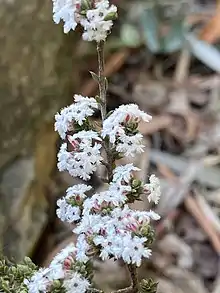| Grey beard-heath | |
|---|---|
 | |
| Scientific classification | |
| Kingdom: | Plantae |
| Clade: | Tracheophytes |
| Clade: | Angiosperms |
| Clade: | Eudicots |
| Clade: | Asterids |
| Order: | Ericales |
| Family: | Ericaceae |
| Genus: | Styphelia |
| Species: | S. attenuata |
| Binomial name | |
| Styphelia attenuata | |
| Synonyms[1] | |
| |
Styphelia attenuata, commonly known as grey beard-heath,[2] is a species of flowering plant in the family Ericaceae. It has grey-green leaves and small white flowers and grows in New South Wales and the Australian Capital Territory.
Description
Styphelia attenuata is a dense shrub usually 20–60 cm (7.9–23.6 in) high and the branchlets have soft, short hairs. The grey-green leaves sit erect or upwardly against the stem, linear or oval shaped, 2–7.2 mm (0.079–0.283 in) long and 0.9–2.1 mm (0.035–0.083 in) wide, upper surface convex in cross section, 3 parallel veins on the underside, margins curved downward with small teeth, and stiff, upright hairs, and the leaf tapering to a small point. The white flowers sit upright in groups of 1-3 in upper leaf axils, bracteoles 1.1–1.4 mm (0.043–0.055 in) long and hairy, sepals 1.9–2.4 mm (0.075–0.094 in) long and the floral tube 1.6–2.1 mm (0.063–0.083 in) long with soft hairs inside and lobes 1.5–2 mm (0.059–0.079 in) long. Flowering occurs from in winter to early spring and the fruit is a small, fleshy brown-green and berry-like, oval-shaped to 3 mm (0.12 in) long, ribbed and smooth.[2][3][4]
Taxonomy and naming
This species was first formally described in 1825 by Allan Cunningham who gave it the name Leucopogon attenuatus in Geographical Memoirs on New South Wales.[5] In 1882, Ferdinand von Mueller transferred the species to Styphelia as S. attenuata in Systematic Census of Australian Plants.[1] The specific epithet (attenuata) means "narrowing to a point".[6]
Distribution and habitat
Grey beard-heath grows in dry, rocky slopes in woodlands and heath on sandy soils in south-eastern Queensland, on the coast, ranges and western slopes of New South Wales and the Australian Capital Territory, and in eastern Victoria.[3][4]
References
- 1 2 3 "Styphelia attenuata". Plants of the World Online. Retrieved 27 September 2023.
- 1 2 Cosgrove, Meredith (2014). Photographic Guide to Native Plants of the Australian Capital Territory. Meadow Argus. ISBN 9780994183408.
- 1 2 Powell, J. "Leucopogon attenuatus". PlantNET-NSW flora online. Royal Botanic Gardens Sydney. Retrieved 7 July 2021.
- 1 2 Walsh, Neville. "Styphelia attenuatus". VICFLORA-Flora of Victoria. Royal Botanic Garden Victoria. Retrieved 8 July 2021.
- ↑ "Leucopogon attenuatus". Australian Plant Name Index. Retrieved 8 July 2021.
- ↑ Sharr, Francis Aubi; George, Alex (2019). Western Australian Plant Names and Their Meanings (3rd ed.). Kardinya, WA: Four Gables Press. p. 140. ISBN 9780958034180.